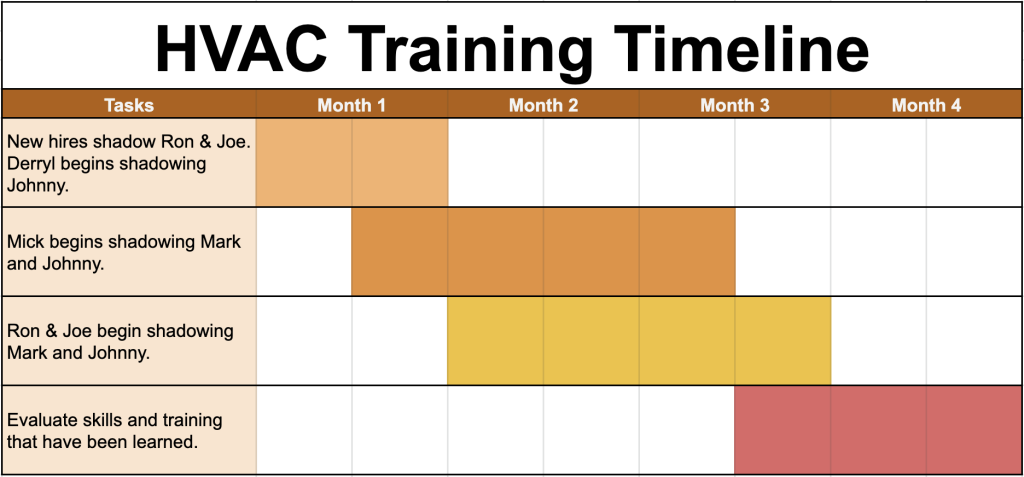- Why you need an effective succession plan.
- How to do succession planning.
- How to decide who will fill what roles once the seller leaves the business.
- How to use a Gantt chart.
- How to implement a referral program.
- Why you need a strong Employee Value Proposition.
In an earlier article, we talked about how creating an employee skills matrix is a lot like downloading a brain. The skills matrix helps you learn what each employee does, how capable they are, and whether anyone is being overworked.
But there’s one person above everyone else whose job you need to understand: the person selling the business.
When you enter the business as the new owner, you know that the seller is leaving. Whether they’re retiring, pursuing a new opportunity, or devoting all of their time to learning the lost art of close-up magic, they’re not going to stick around forever. You need to learn every aspect of what the seller does and you don’t have the luxury of time.
Because of that, the number one thing you need to do after taking ownership of a business is make sure you know what the owner did day-to-day, identify their key relationships, how many roles they hold, and anything else they do that helps the business run. Then you need to teach that knowledge to someone else and assign those roles to other people.
This is what we call a succession management plan.
The Time Crunch

When you purchase a business, you’re likely only going to have three months with the previous owner before they walk off into the setting sun. Six months if you’re lucky.
That puts an incredible amount of pressure on the fact that you need to consume as much of their knowledge as possible in a short time frame. You need to learn how the company works and who makes it work.
Despite the fact that the owners are leaving–or maybe because of it–they’re going to be very busy. They still need to run the business, while teaching you everything they do and getting all of their affairs in order. It’s going to be hectic but it’s imperative for your success to see it all and be a part of the process.
Become Their Shadow
If you’re going to accumulate all of the knowledge that someone has built up over the lifetime of running a business, you have to become their shadow. Follow them around, make note of who they talk to each day, what phone calls they make, and where they go.
Write down every single thing they do. Even if it seems mundane at first, it could become important later. Maybe they always take their coffee break at 11:05 because 5 minutes before is when a big shipment always comes in and 15 minutes later is when he always has to chase off the raccoons that get into the trash at the same time every day.
Look at their responsibilities and decide who else can do them. This is true of most business owners: they wear many hats. And those hats can be given to other workers within the organization. Ideally, this shouldn’t be a personnel consideration or a personal one. It should never be “Suzie can do this instead of Mark,” even if you think Suzie is more capable. Instead, consider what role or position should be undertaking that particular task.
Look for action items. These are things that the owner does that no one else knows how to do. These are especially important because, when that owner leaves, you won’t have anyone else you can ask if you run into trouble.
Of course, you’re going to have to assign those action items to other workers. Often they will become the responsibility of the General Manager or other managers within the company, depending on the size of the organization. In order for this to happen effectively, you will need to come up with a learning plan for them. How are they going to have time to learn from the seller if that person is already swamped and leaving?
The Learning Plan: A Study In HVAC
At one HVAC and plumbing company that we acquired, the owners – we'll call them Mark and Johnny to protect their privacy – have worked at the company since it was founded many years ago. Between the two of them, they wear at least four hats.
Mark is in charge of bidding and estimating, and resource management. Johnny handles ductwork design. They both are in charge of project management, which often entails going to job sites to answer any questions that the crew might have.
“There’s no way I would have known any of this had I not followed them around,” explains Hayden Miyamoto, Acquira co-founder and one of the new owners of the business. “I literally went to jobs with them and saw what they did. I interviewed Mark very, very closely and I found all of these things that only they can do.”
At most other companies, each of these responsibilities would be its own position within the company. Other companies would have a position for estimates and another for project management. Ductwork design would also be a specialized, dedicated position.
What Is A Succession Plan?
The company began as a family-run business. As a result, we were lucky enough to have some family members sticking around–Johnny’s son Joe, Mark’s son Ron, and their cousin Derryl. We needed to decide who was taking over each of these four positions.
We decided that Ron would take over bidding and estimating. Joe would handle project management on top of his previous role of service management, and Derryl would handle duct design.
This, however, creates a brand new problem. If Ron, Joe, and Derryl were already service managers, who is going to replace them in their original positions?
“These guys are already super f**king busy,” says Hayden. “Literally to the point where we’re sitting on a goldmine of … around $400,000 in revenue in requests, but we can’t go to them because we don’t have enough people.”
“These guys are already super f**king busy,” says Hayden. “Literally to the point where we’re sitting on a goldmine of … around $400,000 in revenue in requests, but we can’t go to them because we don’t have enough people.”
Hiring Replacements

At this point, we need to fill those positions through a combination of internal promotion and external hiring.
It’s important to do some internal promotion. Otherwise, your workers are going to be discouraged by their lack of advancement. This presents an opportunity to reward hard workers that already exist within the organization and incentivize other workers with potential future promotions.
In the case of this HVAC business, we conducted interviews with people within the organization and posted job openings looking for new people. We decided to promote two people and hire two from outside of the company.
Of course, these people will need to be trained themselves. Both the folks who were promoted and the new hires will have to shadow the brothers. Their cousin, Derryl, was the only person who could start their position right away, so we had him begin ductwork design right away.
Other than that, we had to set up a schedule where the new hires could shadow Ron and Joe. Once that knowledge was passed on, then Ron and Joe could shadow their fathers.
In this system, you teach the people at the bottom of the knowledge ladder first before the people higher up can pass on their knowledge. Otherwise, you have work that’s not being done and you’re passing up opportunities.
Bringing In The GM
Appointing a General Manager is an excellent way to spur this process on. If the GM comes from outside the company, they can start working right away to learn as much as they can from the owners.
In the case of this company, we hired Mick as our GM. Mick started working right away with Mark to turn everything that Mark does into a system. Mick may even have to take over Mark’s responsibilities in the short term.
Of course, the process of succession planning will be unique to every business. But the important part is to gather as much knowledge as possible from a given position, designate who will take over that position, and decide who will fill the gap left by each person as they advance up the ladder.
The whole succession plan can take a minimum of three months up to a year. We have found that the sweet spot is around six months.
At any rate, you need to identify these key positions early because you cannot undo any mistakes you make. In this specific situation, the sellers are leaving after one year, so you need to start right away.
Creating The System: A Checklist
Here are some questions you can ask yourself to get the process started:
- How much time do I have until the seller leaves?
- Who is involved?
- Who’s learning from the seller?
- Who will replace those people?
- Who can be promoted internally?
In the case of this company, we identified ten people in the process. Mark and Johnny, their sons Ron and Joe, their cousin Derryl, two internal promotions, two external hires, and our GM Mick.
The next step is to outline what each of those people is doing each day for at least one month. We like to use a Gantt chart for this part of the process.
The Gantt Chart
As Eddie Meardon explains on the Atlassian blog:
“A Gantt chart is a project management tool that illustrates a project plan. It typically includes two sections: the left side outlines a list of tasks, while the right side has a timeline with schedule bars that visualize work.”
The chart allows the buyer to create a training schedule so we can mark objectives and note successes. It also shows the new owner how the training will be staggered. Here’s an example of Gantt chart for our training process:

Referral Program
At this point, you may consider implementing a referral program within the company. This is something that Acquira does with many of the companies it acquires.
The principles are basic. You ask everyone within the organization if they know someone who is qualified to do the job you’re trying to fill. In the case of this HVAC company, we were looking for service technicians, so we asked everyone if they knew a service tech who could do the job.
If they recommended someone that we ended up hiring, we paid them a bonus – the same fee we would pay a recruiter. In this instance, that equaled out to one month’s salary split between the person who made the recommendation and the new hire.
The bonus can be paid out in different ways. We generally pay half after the new hire has worked at the company for three months and the second half after six months.
Create An Employee Value Proposition
Finding new hires for your organization takes time. The referral program is a good place to start, but sometimes people are too excited at the prospect of a bonus that they don’t consider who would be the best fit for a company.
As the owner, you need to aim. Some people just want to fire.
The most effective way of attracting the right employees is by creating a strong value proposition. But that takes time.

In order to create a value proposition for potential employees, you need to create a strange culture, a culture where people feel taken care of, and a culture of ownership.
When you’re creating a succession plan, external hires can be a little bit dangerous to the concept of creating this type of culture. By bringing in people who are only interested in money, or who may fill the hole but aren’t necessarily the perfect fit, you can dilute your company culture.
You should strive to create a culture where people want to work. Whether that’s by providing autonomy, high pay, good bonuses, or any other cultural benefit. A company with a strong Employee Value Proposition (EVP) can often attract people who will work for the same amount of money as their previous job, or sometimes even less.
But in order to create that culture, you need time. And when you’re taking over a business, time isn’t a luxury. In these instances, you may need to start by overpaying new hires in order to create a reputation for your business as a place where people want to work. It’s a good way to start building a strong EVP.
When you’re hiring outside people over promoting internally, it’s important to communicate with your existing employees. A skills matrix is an incredibly valuable tool for demonstrating to your workers how they can advance within the company. It can also be used to show them why, at that moment, they’re not right for the open positions while encouraging them to work harder toward advancement.
It’s all about keeping up morale.
Conclusion
When you buy a company, time is not on your side. The seller is walking away from the business and he’s taking all of his accumulated knowledge with him.
An effective succession plan is the best way to avoid any missteps. Because, frankly, you can’t afford missteps at this point. Decide who is taking over for whom, dictate when they will take the time to learn their new responsibilities, and be clear and concise in communicating each part of the plan with the people involved.
Odds are, you’ve experienced the disarray that can happen when someone takes over a new role and isn’t properly trained. And we’d love to hear your horror stories in the comments below! But the truth is, these types of situations are completely avoidable with the right amount of planning and diligence. Succession planning in business is a crucial aspect of servant leadership, a value that we believe is important for any of our acquisition partners.
Whether you’re on the hunt for your first acquisition or you’ve already closed the deal and are preparing to step into your new ownership role, you should be giving strong consideration to your succession plan. If you’ve yet to sign up for Acceleration Gauntlet, we highly recommend it. You can see what resources we offer and avail yourself of our community.
If you found this article useful, please let others know about it. And if you're already completed the gauntlet, schedule a call with us to figure out your next steps!
Key Takeaways
- You need to learn everything that the seller does to make the business operate.
- Decide what position should fill those responsibilities.
- Create a succession plan: who will learn from who and when?
- Use a Gantt Chart to organize everyone’s schedules and define expectations.
- Consider implementing a referral program.
- If you do not have a strong EVP, you may need to overpay your initial outside hires.
Acquira specializes in seamless business succession and acquisition. We guide entrepreneurs in acquiring businesses and investing in their growth and success. Our focus is on creating a lasting, positive impact for owners, employees, and the community through each transition.



